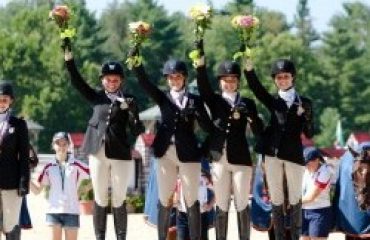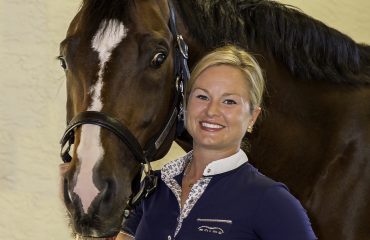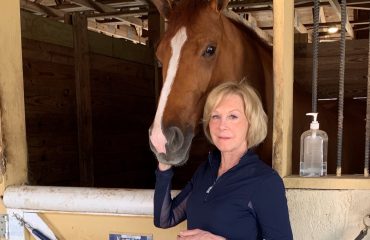
Brian Walker
Photo by Hervé Bonnaud, 1clicphoto.com
Brian Walker, a dual Canadian and American citizen, has trained, worked and ridden alongside the best in the world over the last 25 years. As a junior, Brian won the Maclay Medal Equitation Championship in 2001. Brian has made a name for himself by developing quality horses into successful competitors in both the hunter and jumper arenas, earning accolades for himself and his clients. Do you have a question you want Brian to answer? Send questions to editor@sidelinesnews.com.
My horse spooked at our last competition from the sound of a loud noise, and she’s been a little on edge. How can I help my horse regain her confidence?
Shows have a lot of unexpected adversaries for our horses. Sudden noises can be spooky. If your horse becomes suddenly spooked by a sound at the show and continues to be spooky, you just need to be patient. Your horse will eventually settle. There isn’t a lot to do for it, but what you shouldn’t do is avoid situations where you think your horse might be spooky. You can help the noise by stuffing the horse’s ears to muffle the loud sounds. In the end, time is the only solution.
I’ve been researching how I could ride so that I raise my horse’s back, but I haven’t found anything too useful. Do you have any recommendations for different exercises on how to ride so that I can raise my horse’s back?
The phrase “raise your horse’s back” can’t be taken too literally because it’s more about making your horse sit on their back legs, or have your horse underneath you, and working. When your horse’s balance is on their front legs, their back legs are usually out behind them. You want your horse’s balance to be on their back legs so they can shorten or “sit” when they need to. With some horses, you simply need to ride with more leg to keep a horse’s hind end underneath them. Simple exercises such as going forward and collecting both at trot and canter are good; downward and upward transitions are also helpful; and trotting over poles and raised poles can help get the horse’s back legs underneath the rider, which will give the horse better balance.
Every time my horse is about to jump, he shakes his head right before the fence. I read online that this could be an indication that he doesn’t want to jump the fence. Are there any exercises we could practice so that he gets comfortable with jumping, and doesn’t shake his head before jumps?
I don’t know if I’ve ever heard a horse shaking his head has to do with the horse not wanting to jump, but if that is the case then the solution is simple: You need to practice more. I have seen horses shake their heads because they want to go and the rider is holding them back. Actually, in both cases, I prefer jumping horses over smaller fences more often to get them more comfortable over the jumps. I like using many small jumps for horses that like going too much and tend to get aggressive. With many small jumps, the horse learns that jumping isn’t as stressful as he or she thinks it is. Also, pay attention to see if there is any relation to head shaking and a certain jump height. It’s possible that the horse is shaking his head as a signal that the jump is too high and he doesn’t want to continue at that height.
Based on your experience with competitions and judges, how would you suggest I make a good first impression with the judges at a horse show?
Positive and favorable first impressions are always helpful, but your performance ultimately determines your score for any particular round. A properly turned out horse and rider are the key ingredients for a good first impression. Horses must be clean and shiny, with a nicely-braided mane and tail. Clean tack is also important. The rider should have clean and polished boots, properly fitted attire, gloves, and if the rider is female, her hair should be put up properly in a hair net. Going into the ring, looking the part of a polished rider-and-horse team will help make a good first impression.













